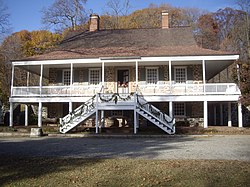Van Cortlandt Manor
Van Cortlandt Manor | |
 | |
| Location | South Riverside Avenue, Croton-on-Hudson, New York |
|---|---|
| Coordinates | 41°11′30″N 73°52′35″W / 41.19167°N 73.87639°W |
| Built | 1665 |
| Architectural style | Dutch-English Colonial |
| NRHP reference No. | 66000579 |
| NYSRHP No. | 11953.000005 |
| Significant dates | |
| Added to NRHP | October 15, 1966[1] |
| Designated NHL | November 5, 1961[2] |
| Designated NYSRHP | June 23, 1980 |
Van Cortlandt Manor is a 17th-century house and property built by the Van Cortlandt family located near the confluence of the Croton and Hudson Rivers in the village of Croton-on-Hudson in Westchester County, New York, United States. The colonial era stone and brick manor house is now a museum and is a National Historic Landmark.
History
[edit]By royal charter, Van Cortlandt Manor was originally a 86,000-acre (35,000 ha) tract granted as a Patent to Stephanus Van Cortlandt in 1697 by King William III, stretching from the Hudson River on the west to the first boundary line between the Province of New York and the Colony of Connecticut, on the east, twenty English miles in width by ten in height, in shape nearly a rectangular parallelogram, forming, "The Manor of Cortlandt." The massive holding was acquired by direct purchase from the Indians, in part, by Stephanus van Cortlandt, a native born Dutch gentleman of New York, and in part by others whose titles he subsequently bought. The Manor also included a small tract on the west side of the Hudson River opposite the promontory of Anthony's Nose, which van Cortlandt also purchased from the Indians.[3]
The Manor House [4] was built sometime before 1732 but was not any owner's principal residence until a grandson, Pierre Van Cortlandt, moved there in 1749.[5] At that time the manor house was on a 1,000-acre (405 ha) portion of the original tract.[2]
Pierre brought his family to the estate in 1749 and created the manor's most vibrant days, according to some. He established a self-sustaining community[6] of an apple orchard, dairy farm, bee house, kiln, tavern, and carpenter and blacksmith shops.
At this time, though, tensions leading to the Revolutionary War were building and the manor would become a place of wartime retreat. Pierre sided with the colonies and the manor was used to assist the Continental Army, using its resources to make food and supplies. Pierre was involved with military legislature, and his son Philip was a soldier for the Continental Army. Eventually Pierre and his family vacated the manor in the thick of the war. The manor was ransacked by the British Army and left in poor standing. Philip, becoming a brigadier general by the war's end, returned and, along with his sister, Catherine, brought the manor back to working order.[7][8]
Van Cortlandt Manor became an essential stop on the route from New York to Albany in the years that followed the war. The mills were once again thriving and provided the community and travelers with food, supplies, and lodging. Pierre and his wife did not return until 1803 once the manor was in full working order again. The manor was passed down in the family until it was sold to a non-relative, Otis Taylor, in 1945. By this time the property had lost luster, and was not the flourishing estate it had once been. Some buildings and barn houses were taken down to accommodate for more modern facilities, such as a drive-in movie theater.[7][8]
In 1953 John D. Rockefeller Jr. purchased the property and began restoring the manor to previous prominence. In 1961, Van Cortlandt Manor became registered as a National Historic Landmark.
The house is not included in the area of the hamlet of Cortlandt Manor, New York. It is one of the historic sites owned and operated by Historic Hudson Valley.
See also
[edit]- List of National Historic Landmarks in New York
- National Register of Historic Places listings in northern Westchester County, New York
References
[edit]- ^ "National Register Information System". National Register of Historic Places. National Park Service. January 23, 2007.
- ^ a b "Van Cortlandt Manor". National Historic Landmark summary listing. National Park Service. September 21, 2007.[dead link]
- ^ Bolton, Robert (1881). The History of the Several Towns, Manors and Patents of the County of Westchester Vol 1. New York: Charles F. Roper. pp. 94–95. Retrieved August 10, 2015.
- ^ "Van Cortlandt Manor--Accompanying photos, exterior, from 1967 and 1974. (National Register of Historic Places Inventory-Nomination)" (pdf). National Park Service. January 1975.
- ^ ""Van Cortlandt Manor", January, 1975, by James Dillon (National Register of Historic Places Inventory-Nomination)" (pdf). National Park Service. January 1975.
- ^ Hall, Barbara (October 19, 1997). "Van Cortlandt Debate Marks Its 300th Year". The New York Times. ISSN 0362-4331. Retrieved November 27, 2023.
- ^ a b Northshield, Lee. "Van Cortlandt Manor". Village of Croton-On-Hudson, NY. Web, 22 Apr. 2015, http://www.crotononhudson-ny.gov/Public_Documents/CrotonHudsonNY_WebDocs/HistoricalSociety/VanCortlandtManor.
- ^ a b Kléber, Louis C. "Van Cortlandt Manor". History Today 30.11 (1980): 62-63. Religion and Philosophy Collection. Web, 24 Apr. 2015.
External links
[edit]- "Van Cortlandt Manor". Historic Hudson Valley. Official Site.
- "The Great Jack O'Lantern Blaze at Van Cortlandt Manor". Historic Hudson Valley.
- "Van Cortlandt Manor". Croton-on-Hudson.
- Houses on the National Register of Historic Places in New York (state)
- National Register of Historic Places in Westchester County, New York
- National Historic Landmarks in New York (state)
- Historic house museums in Westchester County, New York
- Stagecoach stops in the United States
- New York State Register of Historic Places in Westchester County




